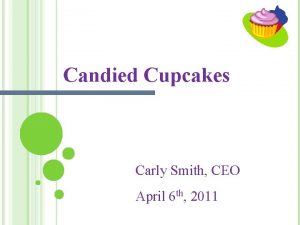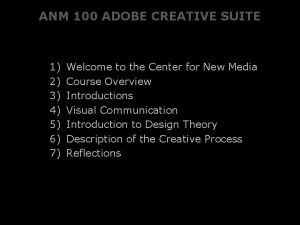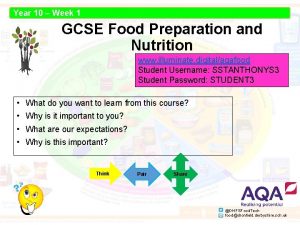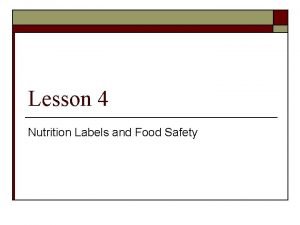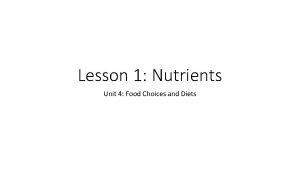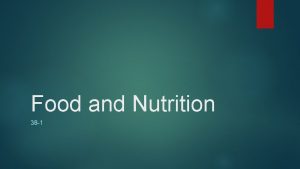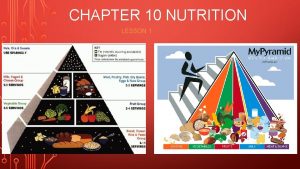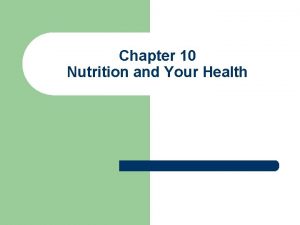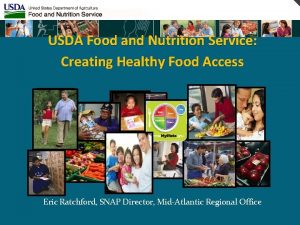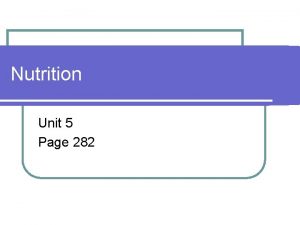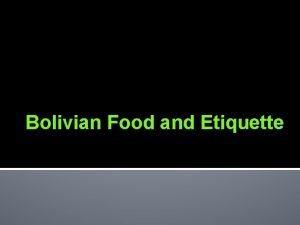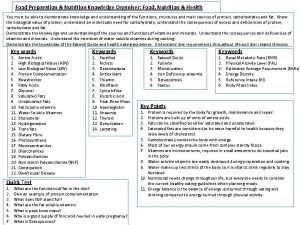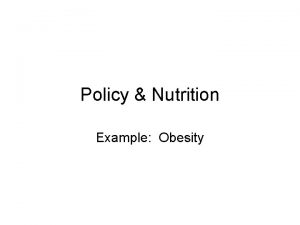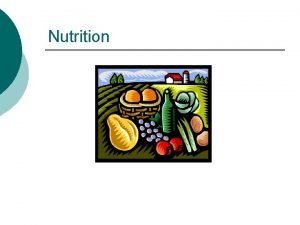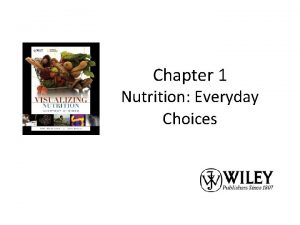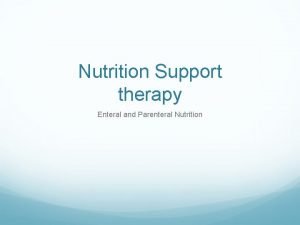Cupcakes for Lunch Creating a Food Nutrition Policy



















- Slides: 19

Cupcakes for Lunch? Creating a Food & Nutrition Policy for your Early Care & Education Program

Rethinking Nutrition Workshop Series 1. Yummy Carrot Sticks: How Children Learn to Like Nutritious Foods • Avoiding food power struggles, Role modeling healthy eating 2. What’s for Snack? Nutrition to Support Healthy Growth • Good nutrition, Lifelong food habits, Obesity 3. Cupcakes for Lunch? Creating a Food & Nutrition Policy for Your Early Care & Education Program • Nutrition policy, Family food practices 4. Count, Read, Share: The Meal Table as a Learning Center • Mealtime learning activities, Life skills, Social skills


Shared Responsibilities • More working mothers and two-income families • Children spend large portion of their day in early care and education settings • 8 hours per day • 2 meals • 2 snacks • Family and child care share responsibilities of caring for children.

Why develop policies? • Families • Alignment of values • Statement of program’s intentions • Clear communication • Staff • • Guide staff training Assist in meeting children’s needs Talking points with families Avoid conflict when challenging beliefs

What challenges or conflicts might families and early care & education providers face in sharing the responsibility of feeding children?

Why Nutrition Policy? • Children may get majority of nutrition from ECE center. • Good nutrition promotes development. • Adult interactions with children during meals and snacks.

Cultural and Dietary Reasons for Nutrition Policy • Food allergies (I. e. , nut or gluten intolerances) • Medical (I. e. , diabetes) • Developmental (I. e. , cannot feed self) • Ethnic or cultural (I. e. , vegetarian) • Religious (I. e. , Kosher foods or fasting)

What do you think should be included in a nutrition policy for an early care & education setting?

National & Local Examples • National & local early childhood organizations have developed nutrition policy guidelines: • National Association for the Education of Young Children (NAEYC) • U. S. Department of Health and Human Services: Head Start • Healthy Bites (WI Departments of Public Instruction, Health Services, and Children & Families) • Use as helpful frameworks for developing local policy.


Before Writing Policies 1. Know state licensing regulations. 2. Gather family information. 3. Assemble an inclusive team. 4. Be general but specific. 5. Be comprehensive.

Write a 3 -5 sentence policy about the food value at the bottom of the page. Fold the paper to hide your writing and pass it to your neighbor.

“Policies alone will not be effective unless they are thoroughly and consistently shared with families and implemented by staff. ” - Rethinking Nutrition, p. 103

How to Put Policies into Practice • Implement policies. • Train staff. • Educate families and children. • Frequently review policies for relevance, effectiveness, and practical implementation.

Have you encountered an emotionally charged issue involving food? If so, how did you handle it? What might you have done differently?

Four Steps to Clearing Misunderstandings 1. Start by stating the other person’s viewpoint. 2. State the program policy and the reason (rationale) for the policy. 3. State a conclusion. • • Re-assert the rule. Compromise. Change the policy. No decision yet. 4. Follow through.

“When they are thoughtfully developed and shared with families and other key stakeholders, policies provide concrete examples of programs values while minimizing misunderstandings and conflicts that might otherwise disrupt the program’s work and the children’s learning environment. ” - Rethinking Nutrition, p. 101

Development of this educational program was made possible by a generous donation from an alumna of the School of Human Ecology, UW-Madison.
 Vision statement for cupcake business
Vision statement for cupcake business Bape cupcakes
Bape cupcakes Map malu perini
Map malu perini Johnny cupcakes net worth
Johnny cupcakes net worth Anm cupcakes
Anm cupcakes History of cupcakes
History of cupcakes Cupcake sizes
Cupcake sizes Unit 2 food food food
Unit 2 food food food Food chain sequence
Food chain sequence Gcse food tech high skill dishes
Gcse food tech high skill dishes Lesson 4 nutrition labels and food safety
Lesson 4 nutrition labels and food safety Food and nutrition unit 4
Food and nutrition unit 4 Section 38-1 food and nutrition
Section 38-1 food and nutrition Rda food label
Rda food label Section 38-1 food and nutrition
Section 38-1 food and nutrition Extreme elite nutrition dog food
Extreme elite nutrition dog food Chapter 10 nutrition for health lesson 1 answer key
Chapter 10 nutrition for health lesson 1 answer key Chapter 10 lesson 4 nutrition labels and food safety
Chapter 10 lesson 4 nutrition labels and food safety Usda food and nutrition service
Usda food and nutrition service Food and nutrition unit 5
Food and nutrition unit 5



